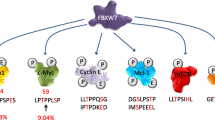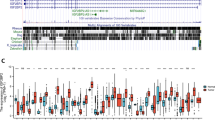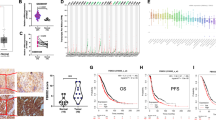Abstract
Two decades ago, following a systematic screening of LOH regions on chromosome 8p22, TUSC3 has been identified as a candidate tumor suppressor gene in ovarian, prostate and pancreatic cancers. Since then, a growing body of evidence documented its clinical importance in various other types of cancers, and first initial insights into its molecular function and phenotypic effects have been gained, though the precise role of TUSC3 in different cancers remains unclear. As a part of the oligosaccharyltransferase complex, TUSC3 localizes to the endoplasmic reticulum and functions in final steps of N-glycosylation of proteins, while its loss evokes the unfolded protein response. We are still trying to figure out how this mechanistic function is reconcilable with its varied effects on cancer promotion. In this review, we focus on cancer-related effects of TUSC3 and envisage a possible role of TUSC3 beyond endoplasmic reticulum.

Similar content being viewed by others
References
Hanahan D, Weinberg RA (2011) Hallmarks of cancer: the next generation. Cell 144(5):646–674
He Q, He Q, Liu X et al (2014) Genome-wide prediction of cancer driver genes based on SNP and cancer SNV data. Am J Cancer Res. 4(4):394–410
MacGrogan D, Levy A, Bova GS, Isaacs WB, Bookstein R (1996) Structure and methylation-associated silencing of a gene within a homozygously deleted region of human chromosome band 8p22. Genomics 35:55–65
Khalid AM, Asano A, Hosaka YZ, Takeuchi T, Yamano Y (2013) Tumor suppressor candidate TUSC3 expression during rat testis maturation. Biosci Biotechnol Biochem 77:2019–2024
Aken BL, Ayling S, Barrell D et al (2016) The Ensembl gene annotation system. Database (Oxford) 2016:baw093. doi:10.1093/database/baw093
Kelleher DJ, Gilmore R (2006) An evolving view of the eukaryotic oligosaccharyltransferase. Glycobiology 16:47–62
Mohorko E, Owen RL, Malojčić G, Brozzo MS, Aebi M, Glockshuber R (2014) Structural basis of substrate specificity of human oligosaccharyl transferase subunit N33/Tusc3 and its role in regulating protein N-glycosylation. Structure 22:590–601
Shrimal S, Cherepanova NA, Gilmore R (2015) Cotranslational and posttranslocational N-glycosylation of proteins in the endoplasmic reticulum. Semin Cell Dev Biol 41:71–78
Horak P, Tomasich E, Vaňhara P et al (2014) TUSC3 loss alters the ER stress response and accelerates prostate cancer growth in vivo. Sci Rep 4:3739
Vaňhara P, Horak P, Pils D et al (2013) Loss of the oligosaccharyl transferase subunit TUSC3 promotes proliferation and migration of ovarian cancer cells. Int J Oncol 42:1383–1389
Cherepanova N, Shrimal S, Gilmore R (2016) N-Linked glycosylation and homeostasis of the endoplasmic reticulum. Curr Opin Cell Biol 41:57–65
Cherepanova NA, Shrimal S, Gilmore R (2014) Oxidoreductase activity is necessary for N-glycosylation of cysteine-proximal acceptor sites in glycoproteins. J Cell Biol 206:525–539
Schwarz M, Knauer R, Lehle L (2005) Yeast oligosaccharyltransferase consists of two functionally distinct sub-complexes, specified by either the Ost3p or Ost6p subunit. FEBS Lett 579:6564–6568
Cherepanova NA, Gilmore R (2016) Mammalian cells lacking either the cotranslational or posttranslocational oligosaccharyltransferase complex display substrate-dependent defects in asparagine linked glycosylation. Sci Rep 6:20946
Molinari F, Foulquier F, Tarpey PS, et al (2015) Oligosaccharyltransferase-subunit mutations in nonsyndromic mental retardation. Am J Hum Gen. 82:1150–1157
Contessa JN, Bhojani MS, Freeze HH, Ross BD, Rehemtulla A, Lawrence TS (2010) Molecular imaging of N-linked glycosylation suggests glycan biosynthesis is a novel target for cancer therapy. Clin Cancer Res 16(12):3205–3214
Goytain A, Quamme GA (2005) Identification and characterization of a novel mammalian Mg2+ transporter with channel-like properties. BMC Genomics 1:48
Zhou H, Clapham DE (2009) Mammalian MagT1 and TUSC3 are required for cellular magnesium uptake and vertebrate embryonic development. Proc Natl Acad Sci USA 106:15750–15755
Pak BJ, Park H, Chang ER, Pang SC, Graham CH (1998) Differential expression display in first analysis trimester of oxygen-mediated human trophoblast changes cells in gene. Placenta 19:483–488
Soleymanlou N, Jurisica I, Nevo O et al (2005) Molecular evidence of placental hypoxia in preeclampsia. J Clin Endocrinol Metab 90(7):4299–4308
Yuen RKC, Avila L, Peñaherrera MS et al (2009) Human placental-specific epipolymorphism and its association with adverse pregnancy outcomes. PLoS ONE 4:1–11
Garshasbi M, Hadavi V, Habibi H et al (2008) Report a defect in the TUSC3 gene is associated with autosomal recessive mental retardation. Am J Hum Genet 2008:1158–1164
Garshasbi M, Kahrizi K, Hosseini M et al (2011) Clinical report a novel nonsense mutation in TUSC3 is responsible for non-syndromic autosomal recessive mental retardation in a consanguineous Iranian family. Am J Med Genet 2011:1976–1980
Maulik PK, Mascarenhas MN, Mathers CD, Dua T, Saxena S (2011) Prevalence of intellectual disability: a meta-analysis of population-based studies: Research in developmental disabilities. Res Dev Dis 32(2):419–436
Hill WD, Davies G, Liewald DC et al (2016) Examining non-syndromic autosomal recessive intellectual disability (NS-ARID) genes for an enriched association with intelligence differences. Intelligence 54:80–89
Khan MA, Rafiq MA, Noor A et al (2011) A novel deletion mutation in the TUSC3 gene in a consanguineous Pakistani family with autosomal recessive nonsyndromic intellectual disability. BMC Med Genet 12:56
Al-Amri A, Saegh AA, Al-Mamari W et al (2016) Homozygous single base deletion in TUSC3 causes intellectual disability with developmental delay in an Omani family. Am J Med Genet 170:1826–1831
Loddo S, Parisi V, Doccini V et al (2013) Homozygous deletion in TUSC3 causing syndromic intellectual disability: a new patient. Am J Med Genet 161:2084–2087
Mosrati MA, Schrauwen I, Kamoun H et al (2012) Genome wide analysis in a family with sensorineural hearing loss, autism and mental retardation. Gene 510(2):102–106
Piovani G, Savio G, Traversa M et al (2014) De novo 1 Mb interstitial deletion of 8p22 in a patient with slight mental retardation and speech delay. Mol Cytogenet 7:25
Zhang Y, Su HJ, Pan KF et al (2014) Methylation status of blood leukocyte DNA and risk of gastric cancer in a high-risk Chinese population. Cancer Epidemiol Biomark Prev 23:2019–2026
Ahuja N, Li Q, Mohan AL, Baylin SB (1998) Issa J-PJ. Aging and DNA methylation in colorectal mucose and cancer. Cancer Res 58:5489–5494
Hanks J, Ayed I, Kukreja N et al (2013) The association between mthfr 677C>T genotype and folate status and genomic and gene-specific dna methylation in the colon of individuals without colorectal neoplasia. Am J Clin Nutr 98:1564–1574
Xu XL, Yu J, Zhang HY et al (2004) Methylation profile of the promoter CpG islands of 31 genes that may contribute to colorectal carcinogenesis. World J Gastroenterol 10:3441–3454
Li Q, Jedlicka A, Ahuja N et al (1998) Concordant methylation of the ER and N33 genes in glioblastoma multiforme. Oncogene 16:3197–3202
Zemlyakova VV, Zhevlova AI, Zborovskaya IB et al (2003) Methylation profile of several tumor suppressor genes in non-small-cell lung cancer. Mol Biol 37:836–840
Duppel U, Woenckhaus M, Schulz C, Merk J, Dietmaier W (2016) Quantitative detection of TUSC3 promoter methylation—a potential biomarker for prognosis in lung cancer. Oncol Lett 2016:3004–3012
Pils D, Horak P, Vanhara P et al (2013) Methylation status of TUSC3 is a prognostic factor in ovarian cancer. Cancer 119(5):946–954
Belshaw NJ, Elliott GO, Foxall RJ et al (2008) Profiling CpG island field methylation in both morphologically normal and neoplastic human colonic mucosa. Br J Cancer 99:136–142
Arasaradnam RP, Khoo K, Bradburn M, Mathers J, Kelly S (2010) DNA methylation of ESR-1 and N-33 in colorectal mucosa of patients with ulcerative colitis (UC). Epigenetics 5:422–426
Yuasa Y, Nagasaki H, Oze I et al (2012) Insulin-like growth factor 2 hypomethylation of blood leukocyte DNA is associated with gastric cancer risk. Int J Cancer 131:2596–2603
Zhang Y, He RQ, Dang YW et al (2016) Comprehensive analysis of the long noncoding RNA HOXA11-AS gene interaction regulatory network in NSCLC cells. Cancer Cell Int 16:89
Scholz C, Nimmrich I, Burger M et al (2005) Distinction of acute lymphoblastic leukemia from acute myeloid leukemia through microarray-based DNA methylation analysis. Ann Hematol 84:236–244
Conway K, Edmiston SN, Tse C-K et al (2015) Racial variation in breast tumor promoter methylation in the Carolina Breast Cancer Study. Cancer Epidemiol Biomark Prev 24:921–930
Bova GS, Carter BS, Bussemakers MJG et al (1993) Homozygous deletion and frequent allelic loss of chromosome 8p22 loci in human prostate cancer. Cancer Res 1993:3869–3873
Emi M, Fujiwara Y, Nakajima T, Cancer C, Cancer L (1992) Frequent loss of heterozygosity for loci on chromosome 8p in hepatocellular carcinoma, colorectal cancer, and lung cancer. Cancer Res 2:5368–5372
Tirkkonen M, Tanner M, Karhu R, Kallioniemi A, Isola J, Kallioniemi OP (1998) Molecular cytogenetics of primary breast cancer by CGH. Genes Chromosome Cancer 21(3):177–184
Bashyam MD, Bair R, Kim YH et al (2005) Array-based comparative genomic hybridization identifies localized DNA amplifications and homozygous deletions in pancreatic cancer. Neoplasia 7:556–562
Takle LA, Knowles MA (1996) Deletion mapping implicates two tumor suppressor genes on chromosome 8p in the development of bladder cancer. Oncogene 12(5):1083–1087
Fujiwara Y, Emi M, Ohata H et al (1993) Evidence for the presence of two tumor suppressor genes on chromosome 8p for colorectal carcinoma. Cancer Res 53(5):1172–1174
Ahmed MN, Kim K, Haddad B, Berchuck A, Qumsiyeh MB (2000) Comparative genomic hybridization studies in hydatidiform moles and choriocarcinoma: amplification of 7q21–q31 and loss of 8p12–p21 in choriocarcinoma. Cancer Genet Cytogenet 116:10–15
Cunningham JM, Shan A, Wick MJ et al (1996) Allelic imbalance and microsatellite instability in prostatic adenocarcinoma. Cancer Res 56(19):4475–4482
Arbieva ZH, Banerjee K, Kim SY et al (2000) High-resolution physical map and transcript identification of a prostate cancer deletion interval on 8p22. Genome Res 10:244–257
Pils D, Horak P, Gleiss A et al (2005) Five genes from chromosomal band 8p22 are significantly down-regulated in ovarian carcinoma: N33 and EFA6R have a potential impact on overall survival. Cancer 104(11):2417–2429
Cooke SL, Pole JCM, Chin S-F, Ellis IO, Caldas C, Edwards PAW (2008) High-resolution array CGH clarifies events occurring on 8p in carcinogenesis. BMC Cancer 8:288
Angstadt AY, Motsinger-Reif A, Thomas R et al (2011) Characterization of canine osteosarcoma by array comparative genomic hybridization and RT-qPCR: signatures of genomic imbalance in canine osteosarcoma parallel the human counterpart. Genes Chromosome Cancer 50:859–874
Griffith OL, Melck A, Jones SJ, Wiseman SM (2006) Meta-analysis and meta-review of thyroid cancer gene expression profiling studies identifies important diagnostic biomarkers. J Clin Oncol 24(31):5043–5051
Chung K-W, Kim SW, Kim SW (2012) Gene expression profiling of papillary thyroid carcinomas in Korean patients by oligonucleotide microarrays. J Korean Surg Soc 82:271–280
Gutierrez VF, Marcos CA, Llorente JL et al (2012) Genetic profile of second primary tumors and recurrences in head and neck squamous cell carcinomas. Head Neck 34(6):830–839
Gu Y, Wang Q, Guo K et al (2016) TUSC3 promotes colorectal cancer progression and epithelial-mesenchymal transition (EMT) through WNT/beta-catenin and MAPK signalling. J Pathol 239:60–71
Kratochvílová K, Horak P, Ešner M et al (2015) Tumor suppressor candidate 3 (TUSC3) prevents the epithelial-to-mesenchymal transition and inhibits tumor growth by modulating the endoplasmic reticulum stress response in ovarian cancer cells. Int J Cancer 137(6):1330–1340
Fan X, Zhang X, Shen J et al (2016) Decreased TUSC3 promotes pancreatic cancer proliferation, invasion and metastasis. PLoS ONE 11(2):e0149028
Jiang Z, Guo M, Zhang X et al (2016) TUSC3 suppresses glioblastoma development by inhibiting Akt signaling. Tumor Biol 37:12039–12047
Gu Y, Pei X, Ren Y et al (2017) Oncogenic function of TUSC3 in non-small cell lung cancer is associated with Hedgehog signalling pathway. Biochim Biophys Acta 1863(7):1749–1760
Mullighan CG, Zhang J, Kasper LH et al (2011) CREBBP mutations in relapsed acute lymphoblastic leukaemia. Nature 471(7337):235–239
Khan MM, Nomura T, Chiba T et al (2004) The fusion oncoprotein PML-RARalpha induces endoplasmic reticulum (ER)-associated degradation of N-CoR and ER stress. J Biol Chem 279(12):11814–11824
Schardt JA, Eyholzer M, Timchenko NA, Mueller BU, Pabst T (2010) Unfolded protein response suppresses CEBPA by induction of calreticulin in acute myeloid leukaemia. J Cell Mol Med 14(6B):1509–1519
Kharabi Masouleh B, Geng H, Hurtz C et al (2014) Mechanistic rationale for targeting the unfolded protein response in pre-B acute lymphoblastic leukemia. Proc Nat Acad Sci USA 111(21):E2219–E2228
Khoury GA, Baliban RC, Floudas CA (2011) Proteome-wide post-translational modification statistics: frequency analysis and curation of the swiss-prot database. Sci Rep 1:90
Li CW, Lim SO, Xia W et al (2016) Glycosylation and stabilization of programmed death ligand-1 suppresses T-cell activity. Nat Commun 7:12632
Lauc G, Huffman JE, Pucic M et al (2013) Loci associated with N-glycosylation of human immunoglobulin G show pleiotropy with autoimmune diseases and haematological cancers. PLoS Genet 9(1):e1003225
Liu K, Xie F, Gao A et al (2017) SOX2 regulates multiple malignant processes of breast cancer development through the SOX2/miR-181a-5p, miR-30e-5p/TUSC3 axis. Mol Cancer 16(1):62
Pole JCM, Courtay-Cahen C, Garcia MJ et al (2006) High-resolution analysis of chromosome rearrangements on 8p in breast, colon and pancreatic cancer reveals a complex pattern of loss, gain and translocation. Oncogene 25:5693–5706
Ribeiro IP, Marques F, Caramelo F et al (2014) Genetic gains and losses in oral squamous cell carcinoma: impact on clinical management. Cell Oncol 37:29–39
Yu X, Zhang K, Liu F et al (2016) Tumor suppressor candidate 3 as a novel predictor for lymph node metastasis in lung cancer patients. Oncol Lett 2016:5099–5105
Guervos MA, Marcos CA, Hermsen M, Nuno AS, Suarez C, Llorente JL (2007) Deletions of N33, STK11 and TP53 are involved in the development of lymph node metastasis in larynx and pharynx carcinomas. Cell Oncol 29(4):327–334
Yu X, Zhang J, Zhong H et al (2016) Decreased tumor suppressor candidate 3 predicts poor prognosis of patients with esophageal squamous cell carcinoma. Int J Med Sci 13:963–969
Peng Y, Cao J, Yao XY, Wang JX, Zhong MZ, Gan PP, Li JH (2017) TUSC3 induces autophagy in human non-small cell lung cancer cells through Wnt/β-catenin signaling. Oncotarget 8:52960–52974
Author information
Authors and Affiliations
Contributions
KV drafted the manuscript, PH and PV conceptualized, wrote and revised the manuscript.
Corresponding author
Ethics declarations
Funding
Grant Agency of Masaryk University (MUNI/A/1369/2016), European Regional Development Fund (Center for Analysis and Modeling of Tissues and Organs, CZ.1.07/2.3.00/20.0185), the National Program of Sustainability II (Project no. LQ1605, MEYS CR).
Conflict of interest
Authors declare no conflict of interest.
Rights and permissions
About this article
Cite this article
Vašíčková, K., Horak, P. & Vaňhara, P. TUSC3: functional duality of a cancer gene. Cell. Mol. Life Sci. 75, 849–857 (2018). https://doi.org/10.1007/s00018-017-2660-4
Received:
Accepted:
Published:
Issue Date:
DOI: https://doi.org/10.1007/s00018-017-2660-4




